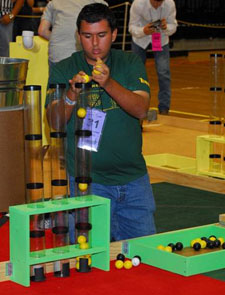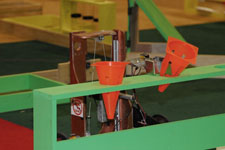Total Recall
Teams are tasked with performing product manufacturing operations on two independent production lines. The objective is to process and package as much “good” product as possible while striving for Six Sigma quality levels on each production line. Some products for each line will be identified as “defective” and will be “recalled”. For the gadget (golf ball) production line, the defective products should be placed in the mobile recall trailer which must be positioned in the recall area prior to the end of the match. For the gizmo (plastic eggs) production line, the defective products should be left on, or returned to, their original staging area. The numbers of each type of defective product that enter the production stream are tracked and used to compute a defect ratio which is used to establish the process “sigma” level. The sigma level for each production line becomes a multiplier to the point value of the good parts produced on that product line.
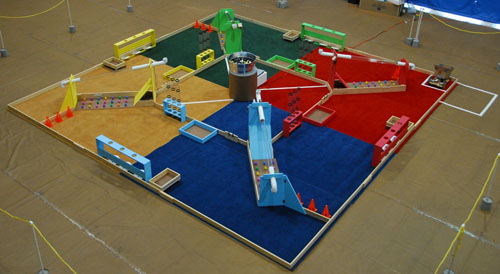
The field consists of a central area surrounded by four factory areas (one per team). The spotters are located in the center area along with the pool of gadgets. The machines start in the corners of the field near the driver locations. Each machine is confined to its factory and may not interfere with the other teams.
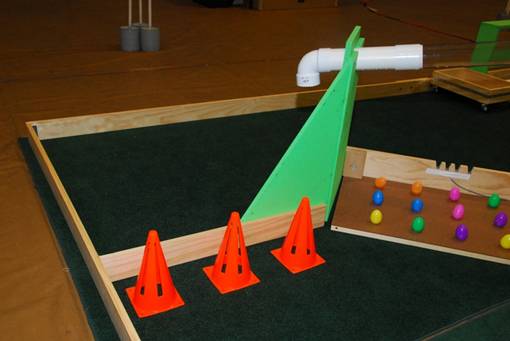 |
There are three different colors of gadgets that are shared by all teams and are initially located in a tub in the center of the field. In addition, there are 6 gadgets (2 of each color) pre-loaded in each scanning tube at the start of the match. The initial 6 gadgets are held in the tube by a block that can only be removed while the mobile recall trailer is docked and the indicator light is on. The spotter is responsible for loading gadgets into the scanning tube which is the only way for the gadgets to enter into production. The spotter is also responsible for sorting and packing the gadgets after the robot has deposited them in the gadget sorting area. The spotter can place gadgets retrieved from the sort area in the packing tubes or into the mobile recall trailer. Each packing tube must contain only one color gadget. To avoid a decrease in the production quality, recalled gadgets should be placed into the mobile recall trailer and the trailer must be moved to the recall area prior to the end of the match.
|
|
The gizmos are initially located on a platform within the team’s factory. Gizmos contain either magnets or marbles, but the color of the gizmo has no relationship to what it contains. Gizmos are to be packaged inside the plastic cones that must be placed, upside down, into the shipping rack. To complete the package, a lid (Frisbee) is placed on top of the cone. Gizmos and their associated packaging can only be manipulated by the robot. Recalled gizmos that are packed with good gizmos decrease the production quality and affect the sigma value.
The color of the recalled gadget, and the type of gizmo (magnetic vs. non-magnetic) is randomly assigned to each team at the beginning of each match. At any point during the match, the team robot can interface to their factory data port and read an indication of which products are defective. Half-way through the match, indicators on the field, which can only be viewed by the spotter, will visually provide the same information that is available through the factory data port. This information is also displayed on the scoring screens.
The table below gives the point values for each non-recalled product and the packaging. In addition to accumulating points for properly sorting and packaging products, the quality of products produced in each product line is independently tracked and used to compute a “sigma” quality level that becomes a multiplier for the points associated with that production line. For each match where both product types are processed, there is a dual-production bonus assigned to the match. Sigma values for both product lines multiply the dual-production bonus points.
Description |
Value |
Gadgets in Sorting Area |
2 |
Same Color Gadgets in Packing Tube |
3 |
Packaged Gizmos in Pack & Ship Center |
10 |
Sealed Gizmos in Pack & Ship Center |
20 |
Gizmo Packages in Pack &Ship Center |
50 |
Dual Production Bonus |
1 |
The total point value is an accumulated count of good products combined with the sigma values associated with the production, over a number of matches. The total points are computed as:
Points = Gizmo Sigma * Gizmo Points +
Gizmo Package Points +
Gadget Sigma * Gadget Points +
10 * Dual Production Bonus * Gizmo Sigma * Gadget Sigma
Sigma values are computed based on the ratio of good products to the total number of products including waste and defective products that are not properly recalled. The chart to the right shows the range of sigma values that can be achieved.
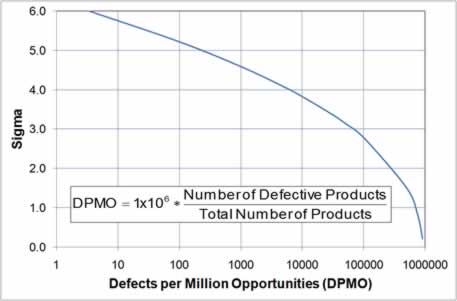
The contest is comprised of three phases: a partial round robin seeding competition, a six game round robin semi-final between the top eight teams, and a three game round robin final between the top four teams. The team’s accumulated score during the seeding competition will be used to rank the team and to determine seven of the eight teams that will advance to the semi-final round robin playoff. The eighth team for the semi-finals will be the winner of a single “wildcard” game. The participants for the wildcard game are selected based on the score of their engineering notebook. .
At the start of the semi-finals, the scores will be reset to zero. For the semi-final round robin playoff, the top eight teams will each play three matches. The total of each team’s scores for these three matches will determine which four teams advance to the finals. Points accumulated during the semi-final competition will carry forward into the final competition. The top four teams will play three additional matches to determine the final ranking order.

 Announcements
Announcements











